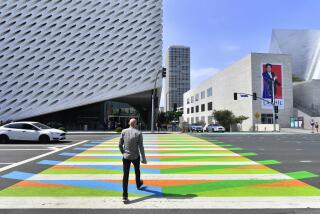The plight of the 104: Too artsy even for Paris?
Leaning his bearded chin against the long handle of a wooden hammer, Michelangelo Pistoletto appeared lost in contemplation as he gazed at a large, framed mirror at the “104 Centquatre” in northeastern Paris. While 200 people gathered round for a better look, Pistoletto suddenly walked to the other side of the room and slammed the hammer against a mirror there. He left a halo of shimmering cracks, and the group, giggling, followed the 77-year-old Italian artist around the room, while he smashed several more mirrors, as part of a program aimed at resuscitating the art center.
The renovated former municipal funeral parlor, which doubles as a partly covered public street, has been the scene of much excitement and confusion. Open since October 2008, the mostly publicly funded space roused expectations with an initial half-promise to become the next alternative hot spot in a lumbering contemporary art scene. But in the following months, the place felt deserted — of both material and visitors. French news sources like the daily Le Monde dubbed the project a “fiasco,” and its two directors, Robert Cantarella and Frédéric Fisbach, well-known theatre directors, resigned.
The 104 wasn’t entirely to blame, said Christophe Girard, culture deputy to the mayor of Paris. “Parisians complain. That’s in our nature,” he said, explaining one reason for the absence of foot traffic. He said many were under the illusion the 104, built on the edge of the city in the 19th arrondissement, was too far from the center.
Another favorite topic of complaint here is a perceived lack of bohemian buzz in a city once known to sizzle. Many worry the city’s innovative artistic voices are muffled by expensive living costs and lack of space, as well as general cultural conservatism. Artists here “don’t have the same level of impact as American artists, for instance,” says Laurent P. Berger, who completed a residency at the 104. “But there is an economic difference between the two countries, with fewer collectors here and less money.”
France plays a tug of war with its creative right half, pulling for nostalgic attachment to heritage on one side, and surprising bursts of innovation on the other. “Because the past is very heavy, because there is a very rich cultural history, and you don’t have as much openness, there is somehow a sort of defiance for things which are new,” says Alexandre Carel, head of the contemporary art department at the Paris branch of Christie’s, the art auction house. “France does not strike me as a place to create. Not like Berlin, which is this sort of destroyed city,” begging to be rebuilt, he said.
Yet, though Paris is no longer wooing artists the way it did when Picasso was painting here in the first half of the 20th century, Carel says a growing art market has gained attention. And “the 104 was supposed to be a niche to bring new artists. That was their ambition. ,” said Berger.
The original concept also included an idea that sounded a lot better on paper: The place was to focus on showing artists at work, instead of their finished projects. The idea, seen as progressive, intended to pull the public into the artistic process and make the space a production hub. Yet without exhibiting art as their main objective, plus high overhead costs the result left too little on view at any given time.
To José-Manuel Gonçalvès, who was ushered in as the new director, problems under the previous program seem clear. On the job since September, he says downplaying the need for artists to communicate through completed works “was unrealistic,” even smacking of pretension. Under Gonçalvès, some performers can be viewed during rehearsals, but “now we make rendezvous with the public, not just when artists work, but also when the thing is finished,” he said.
He also hosted a recent dinner to get locals acquainted with the place — meeting with a key goal for the city to improve life in the lower income area, diverse with immigrant families from North and Western Africa, and often associated with cases of gang-related violence.
Gonçalvès knows that with his new job, he plunged into a sea of bitter impressions about what the 104 has become, or never became. Unlike other art centers in France, the 104 is meant to be a miniature “city of public arts” rather than a museum, with a Sunday farmers market, a bookstore, two cafes, daycare, free qicong martial arts classes and a French equivalent of the Salvation Army. It even feels like a world apart, because of its large scale. Open every day, locals can wander in and out, and hip-hop groups practice dances near street benches, where groups of kids from nearby housing projects hang out after school.
To the director, “serious” contemporary art is also about involving large crowds, and creating an eclectic experience including critically acclaimed creators. “I prefer the idea of being a space that fits. Not avant-garde, and especially not of the rear-guard either. But to be a place of the present,” he says.
“Here you think, a gallery or a museum of contemporary art — and at the same time it’s a performance space, and at the same time it’s street theatre, and at the same time on Sunday people come to run errands, buy food, or exercise,” said Gonçalvès, visibly excited. “It’s a vision of a city that experiences moments. All of it is part of an art de vivre, in the end. That is important, because in art de vivre, there is the word ‘art.’”
Lauter is a special correspondent.
More to Read
The biggest entertainment stories
Get our big stories about Hollywood, film, television, music, arts, culture and more right in your inbox as soon as they publish.
You may occasionally receive promotional content from the Los Angeles Times.






